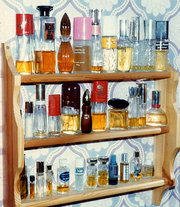
Perfume is a mixture of fragrant essential oils and aroma compounds, fixatives, and solvents used to give the human body, objects, and living spaces a pleasant smell. The amount and type of solvent mix with the fragrance oil dictates whether a perfume is considered a perfume extract, Eau de parfum, Eau de toilette, or Eau de Cologne.
It is impossible to describe a perfume according to its components because the formulas are kept secret. Even if the formulas are known, the ingredients are often too numerous to provide a useful classification. Cognoscenti can, however, generally get a handle on the principal ingredients. On the other hand, it is possible to group perfumes into olfactive families and describe them through the notes that appear as they slowly evaporate. Perfumes can also be classified according to their concentration.
Olfactive families
Fragrances can be classified into several olfactive families, by the themes, or accords, of these fragrances.
Floral: Fragrances that are dominated by the scent of one or more types of flowers. When only one flower is used, it is called a soliflore (as in Dior's Diorissimo, with lily of the valley).
Chypre: Fragrances built on a similar accord consisting of bergamot, oakmoss, pachouli, and labdanum. This family of fragrances is named after a perfume by François Coty by the same name. Meaning Cyprus in French, the term alludes to the inspiration behind the original creation.
Aldehydic: Fragrances that incorporate the family of chemicals known as aldehydes. Chanel No 5 was the first aldehydic perfume (created by the French perfumer Ernest Beaux in 1921). Others include Je Reviens and Arpege. Aldehydic perfumes have the characteristic "piquant" note produced by materials like Aldehyde C12 MNA.
Fougère: Fragrances built on a base of lavender, coumarin and oakmoss. Many men's fragrances belong to this family of fragrances, which is characterized by its sharp herbaceous and woody scent.
Leather: A family of fragrances which features the scents honey, tobacco, wood, and wood tars in its middle or base notes and a scent that alludes to leather.
Woody: Fragrances that are dominated by the woody scents, typically of sandalwood and cedar. Patchouli, with its camphoraceous smell, is commonly found in these perfumes.
Orientals or ambers: A large fragrance class featuring the scents of vanilla and animal scents together with flowers and woods. Can be enhanced by camphorous oils and incense resins, which bring to mind Victorian era imagery of the Middle East and Far East.
Citrus: An old fragrance family that until recently consisted mainly of "freshening" Eau de colognes due to the low tenacity of citrus scents. Development of newer fragrance compounds has allowed for the creation of primarily citrus fragrances.
by:answer.com
0 ความคิดเห็น:
Post a Comment